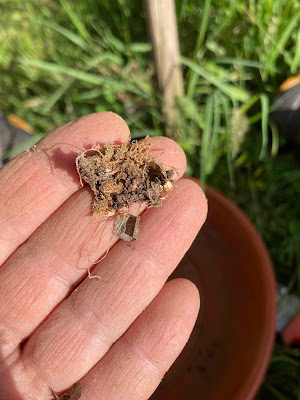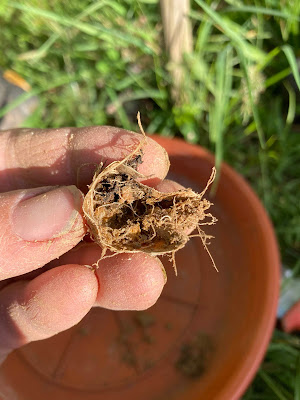I never feel luckier to live here on this 80-acre sanctuary I call Indigo Hill than in mid-June, when everything--everything--is making babies. As I sit at my desk, there are red-bellied woodpeckers and downy woodpeckers feeding young just outside the window. I can hear two of the five indigo buntings on the land singing their heads off. Fledgling eastern bluebirds are churring, being fed. A prairie warbler sings in the birch out the south studio window. This morning, I watched our male pine warbler feed a couple of fledglings in the row of tall Virginia pines that edge the meadow. The breeze is sweeping through the house, the tall grass is waving around blooming butterfly weed, and it is grand, simply grand.
I'm learning how to find box turtle nests. I've been looking for years, but the skunks and raccoons almost always get to them before I do. Oh, how I hate to find dug-out nests, but I find them every year. Last year was a warmup--I got out early, found and protected two before the mammals got them. One nest hatched successfully in the first week of November--late late late! I wrote about it in "Another Box Turtle Morning" a few posts back. By May 29, I had decided to dig up the second nest, figuring the eggs were bad, or the babies had gotten entombed. That was an interesting exercise. I found the remains of four eggs, and the closer I looked, the more I discovered. There were embryos, all right, but they did not seem to be fully developed, because there was a lot of yolk, too, which seemed to have gotten saponified in the process of decomposition. It's the yellowish white stuff here.
In this shot, you can see a scute, or scale, from the baby's shell at the bottom of the mess. So they were pretty well-developed when they died.
There were embryos in all four, with shell scutes and and wee tiny vertebrae. It made me sad. I don't know why they didn't hatch. The nest was in a pretty shady area and I'm guessing they might not have gotten sufficient sun to warm them enough to develop all the way. The small cement block I put on the cage with which it was protected may have blocked even more sun. Sometimes in trying to help, we harm. I don't know. I just knew they didn't make it, and that I needed to do better by the next nests I found.
We don't want this--babies dead in shell. What we want is this. Here's the only hatchling I found of four from the other nest, in the sun-drenched middle path of the meadow. The others dug out and got away before I found them, in early November 2022. This lil fella hatched but decided to stay in the nest chamber over the winter (not uncommon). I felt him in there, then saw him with my phone flashlight. I covered the hole with loose soil and left him all winter long, and he dug out on April 26!
I carried him down into the woods and let him go near a stream. Long may he crawl.
Finding a juvenile box turtle on my land is the sweetest reward for my work. I found this little beauty, about the size of a lime, on June 4, 2023, on the first rainy morning in quite awhile.
I didn't pick him up or disturb him unduly, just made a couple shots and walked on.
Found this old gent in the driveway May 13--doubtless looking for a hen to impregnate.
This spring, I was determined to find the female box turtles while they were laying, which is from the first to third week of June. They need heavy rain to soften the soil enough so it can be dug, and we didn't get that until June 3. On June 4, Phoebe, Liam and I went out looking, and we found three hen turtles making test digs that very evening!
They are very wary while digging, and we didn't approach them--just took a quick snapshot and walked on as if we hadn't registered them.



















0 comments:
Post a Comment